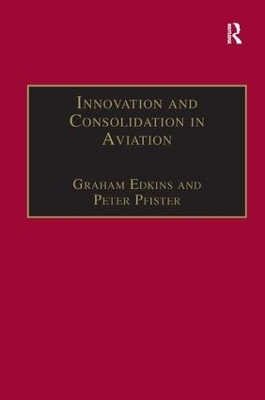
Innovation and Consolidation in Aviation
Routledge (Verlag)
978-0-7546-1999-4 (ISBN)
- Titel z.Zt. nicht lieferbar
- Versandkostenfrei
- Auch auf Rechnung
- Artikel merken
This unique book expands the contribution of aviation psychology and human factors to the aviation industry within the Asia Pacific region, with participation from many other parts of the globe, and key local and international experts, developing the safety, efficiency and viability of the industry. It is a forward-looking work, providing new strategies for psychology and human factors to increase the safe and effective functioning of aviation organisations and systems, pertinent to both civil and military operations. This is the formal refereed proceedings of The Fifth Australian Aviation Psychology Symposium, Manly Beach, Sydney 2000. The symposium had a diverse range of contributions and Development Workshops, bringing together practitioners from aviation psychology and human factors, flight operations management, safety managers, pilots, cabin crew, air traffic controllers, engineering and maintenance personnel, air safety investigators, staff from manufacturers and regulatory bodies, and applied aviation industry researchers and academics. This book will be of interest to anyone involved in human factors, safety systems or aviation psychology within both the civil and military aviation industry.
Graham Edkins, Department of Infrastructure, Australia, and Peter Pfister, University of Newcastle, Australia Robert Lee, James Reason, Daniel E. Maurino, Robert L. Helmreich, James R. Klinect, John A. Wilhelm, Rhona Flin, Ron Westrum, Nick McDonald, Erik Hollnagel, Penelope M. Sanderson, Mike O'Leary, Ian Lucas, Graham Edkins, Barbara Klampfer, Ruth Haeusler, Werner Naef, Marilyn Sue Bogner, Jan M. Davies, John Wreathall, Ashleigh Merritt, David O'Hare, Gary Klein, Peter Maschke, Klaus-Martin Goeters, Mark Wiggins, Oliver Lods, Susannah J. Tiller, Peter Pfister, Allen T. G. Lansdowne, Stephen C. Provost, David J. Allerton, Graham J. F. Hunt, Richard Macfarlane, Mick Toller, Karen L. Stephan, Sean E. Smith, Simon P. A. Parker, Russell L. Martin, Ken I. McAnally, Kathleen L. Mosier, Jeffrey Keys, Robert Bernhard, Andrew Neal, Michael Humphreys, David Leadbetter, Peter Lindsay, Michael D. Nendick, Ross St. George, Kurt M. Joseph, Kevin Williams, Anne R. Isaac, Shayne Loft, Michael Humphreys, Andrew Neal, , John Allin Brown, Jean-Jacques Speyer, Adrian Elsey, Philippe Cabon, Regis Mollard, Samira
Contents: Foreword, Robert Lee. Part I: System Safety and Accident Prevention: Heroic compensations: the benign face of the human factor, James Reason; Aviation safety and human factors: the years to come, Daniel E. Maurino; Managing threat and error: data from line operations, Robert L. Helmreich, James R. Klinect and John A. Wilhelm; Management influence on safety climate, Rhona Flin; Models of bureaucratic failure, Ron Westrum; Culture, systems and change in aircraft maintenance organization, Nick McDonald; Barrier analysis and accident prevention, Erik Hollnagel; Cognitive work analysis across the system life-cycle: achievements, challenges and prospects in aviation, Penelope M. Sanderson; Human factors reporting and situation awareness, Mike O'Leary. Part II: Contrasting Human Factors Applications in Aviation, Healthcare and Nuclear Power: Threat and error in aviation and medicine: similar and different, Robert L. Helmreich; Managing human factors at Qantas: an investment in the future, Ian Lucas and Graham Edkins; CRM behaviour and team performance under high workload: outline and implications of a simulator study, Barbara Klampfer, Ruth Haeusler and Werner Naef; Stretching the search for the 'Why' of error: the system approach, Marilyn Sue Bogner; Betty and the general, Jan M. Davies; Managing human performance in the modern world: developments in the US nuclear industry, John Wreathall and Ashleigh Merritt. Part III: Training, Licensing and Regulations: Artificial seasoning: enhancing experience-based training for aviation, David O'Hare; Decision skills training for the aviation community, Gary Klein; Ab-initio flight training and airline pilot performance: differences in job requirements, Peter Maschke and Klaus-Martin Goeters; Validating a computer-based training tool for in-flight weather-related decision-making, Mark Wiggins, David O'Hare and Oliver Lods; Learning to land: the role of perceptual feedback and individual differences, Susannah J. Tiller, Peter Pfister, Allen T. G. Lansdowne, Stephen C. Provost and David J. Allerton; A cognitive approach to the development of prescriptions for a new flight crew licence: psychological perspective from a regulator and curriculum designer, Graham J. F. Hunt and Richard Macfarlane; Legislating behaviour: the regulator's dilemma, Mick Toller. Part IV: Automation and Human Computer Interaction: Auditory warnings in the cockpit: an evaluation of potential sound types, Karen L. Stephan, Sean E. Smith, Simon P. A. Parker, Russell L. Martin and Ken I. McAnally; Dealing with conflicting information: will crews rely on automation?, Kathleen L. Mosier, Jeffrey Keys and Robert Bernhard; Development of hazard analysis techniques for human-computer systems, Andrew Neal, Michael Humphreys, David Leadbetter and Peter Lindsay; General aviation pilot attitudes towards GPS use: operational implications, Michael D. Nendick, Ross St. George, Kurt M. Joseph and Kevin Williams. Part V: Human Factors Applications within the ATS Environment: Protecting the ATM system from human error: the JANUS approach, Anne R. Isaac; Prospective memory in air traffic control, Shayne Loft, Michael Humphreys and Andrew Neal; Human factors issues in CPDLC, John Allin Brown. Part VI: Other Human Factors Issues: Alertness and awareness of long haul aircrews: the contribution of a new interface concept as an effective fatigue countermeasure, Jean-Jacques Speyer, Adrian Elsey, Philippe Cabon, Regis Mollard, Samira Bougeois-Bougrinne, Nicolas Parriaux and Marc Perrinet; Inadvertent slide activation, Dieter Reisinger.
| Erscheint lt. Verlag | 12.11.2003 |
|---|---|
| Verlagsort | London |
| Sprache | englisch |
| Maße | 156 x 234 mm |
| Gewicht | 830 g |
| Themenwelt | Geisteswissenschaften ► Psychologie |
| Technik ► Fahrzeugbau / Schiffbau | |
| Technik ► Luft- / Raumfahrttechnik | |
| ISBN-10 | 0-7546-1999-0 / 0754619990 |
| ISBN-13 | 978-0-7546-1999-4 / 9780754619994 |
| Zustand | Neuware |
| Haben Sie eine Frage zum Produkt? |
aus dem Bereich


